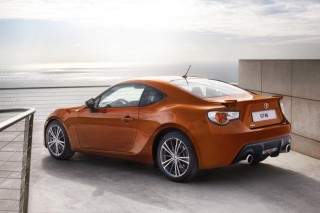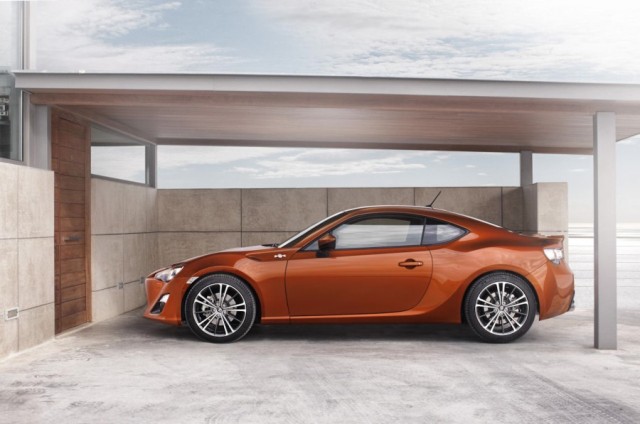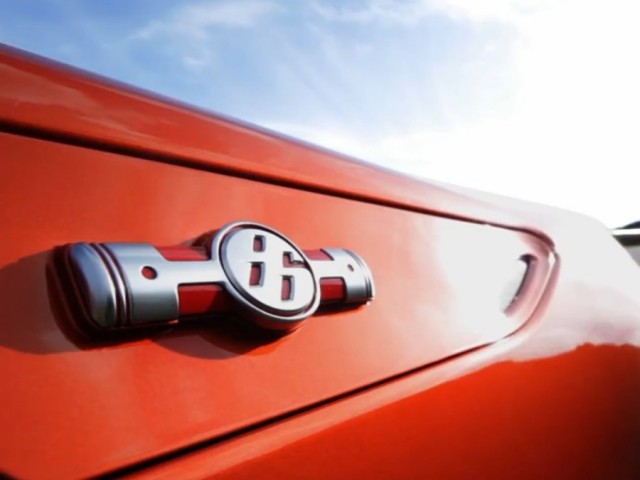Remember the Subaru BRZ Concept we showcased? It’s Toyota sibling, previously known to us as the Toyota FT-86 II Concept, has now been unveiled by Toyota UK just ahead of its debut at the Tokyo Motor Show. Christened the Toyota GT 86, this rear wheel drive compact four seater will be powered by a 2.0 litre boxer engine with D4-S injection will put out 197 hp @ 7,000 rpm and 151 lb-ft (205 Nm) @6,600 rpm.
Toyota says the instead of installing a heavy engine with huge displacement, it has decided to go back to its sporting roots and built a lightweight, two litre boxer engine, front mounted and driving the rear wheels. The powertrain is placed in what Toyota says is the world’s most compact four-seat design to create a car that benefits from light weight, low inertia and a low centre of gravity to achieve the best possible power-to-weight ratio.
Toyota says the design is reminiscent of Toyota’s sports cars of yesteryear with the evocative, sweeping styling. The design has been executed within the technical constraints of achieving the most compact dimensions possible, a low centre of gravity and aerodynamic performance inspired (dictated?) by motorsport technology.
 Toyota’s new design language aims to project a really low slung car, and hence the large lower grille. The lower grille’s “scorpion” look gives the GT 86 a powerful appearance. The 17-inch alloy wheels, rear spoiler, twin exhausts add to the sporty appeal of the car. The best part about the design, the “86” piston logo. It denotes the car’s special powertrain configuration. The 86 is an ode to the square boxer engine with a bore and stroke of 86mm. The boxer engine, denoted in the logo with two horizontally opposed pistons and the 86 in between in stylized font. Way to go Toyota!
Toyota’s new design language aims to project a really low slung car, and hence the large lower grille. The lower grille’s “scorpion” look gives the GT 86 a powerful appearance. The 17-inch alloy wheels, rear spoiler, twin exhausts add to the sporty appeal of the car. The best part about the design, the “86” piston logo. It denotes the car’s special powertrain configuration. The 86 is an ode to the square boxer engine with a bore and stroke of 86mm. The boxer engine, denoted in the logo with two horizontally opposed pistons and the 86 in between in stylized font. Way to go Toyota!
Toyota has taken extra pains to deliver the best possible experience for the driver inside the car. The 365mm diameter steering wheel happens to be the smallest ever in a Toyota, and is wrapped in buckskin based on extensive feedback from test drivers, to offer optimum grip and best steering performance.
The three-meter instrument cluster is arranged around a large tachometer, with efforts made towards establishing the best positioning of the displays, markings and typeface. The result is the best possible visibility and readability says Toyota. The driver-focus of the cockpit is further reinforced by the carbon-effect trim, all-black roof lining, red stitching on the upholstery, aviation-style rocker switches and lightweight, aluminium pedals.
The GT 86 measures 4,240mm long, 1,285mm high and 2,570mm wide, dimensions which make it the most compact four-seater sports car available today.
The powertrain and the driving position have been set as low and as far back as possible to achieve a near-perfect 53:47 front-to-rear weight distribution. The flat-four engine format and the driver’s hip point together give the GT 86 an ultra-low centre of gravity, at just 475mm.
The GT 86 makes the most of a light kerb weight, making it easy for drivers to exploit its nimble handling and cornering poise. The suspension features MacPherson struts at the front and double wishbones at the rear. The car rides on 17-inch wheels and is fitted with ventilated disc brakes front and rear.
The D-4S 2.0L Boxer Engine
The GT 86’s engine is the result of a joint Toyota and Subaru development programme. Toyota has added its D-4S injection technology to Subaru’s new, horizontally opposed, naturally aspirated 1,998cc four-cylinder boxer engine. This system features separate twin injectors for both direct and port injection, and a high 12.5:1 compression ratio, increasing power and torque across a wide range of engine speeds without sacrificing fuel efficiency.
The flat-four engine has equal bore and stroke of 86 mm and drives through either a six-speed manual or six-speed automatic transmission. The manual offers quick, precise shifts using a tactile, short-throw lever; the automatic transmission can be controlled using paddle shifts mounted on the steering wheel.
Power is distributed to the rear wheels via a limited slip differential to give the best possible grip in all driving conditions. Toyota repeatedly stresses that to ensure pure driving bliss, electronic intervention will be minimal. The ABS and switchable vehicle stability control systems have been tuned specifically to deliver dynamic stability at the limit of the car’s performance envelope with minimal electronic intervention.
Toyota’s two-cylinder boxer-engined Sports 800, which the company began developing in 1962 is the world’s first sports car to feature a front-mounted, horizontally opposed engine and rear-wheel drive.
The inspiration for the GT 86, however, is the Corolla GT (or Levin) AE86, a car with an enduring reputation for delivering sheer excitement and capturing the fundamental joy of driving. Its front-engine, rear-wheel drive package, compact dimensions, light weight, impeccable balance and superior power-to-weight ratio made it a must-have choice for rallying and circuit driving throughout its production life, from 1983 to 1987.






